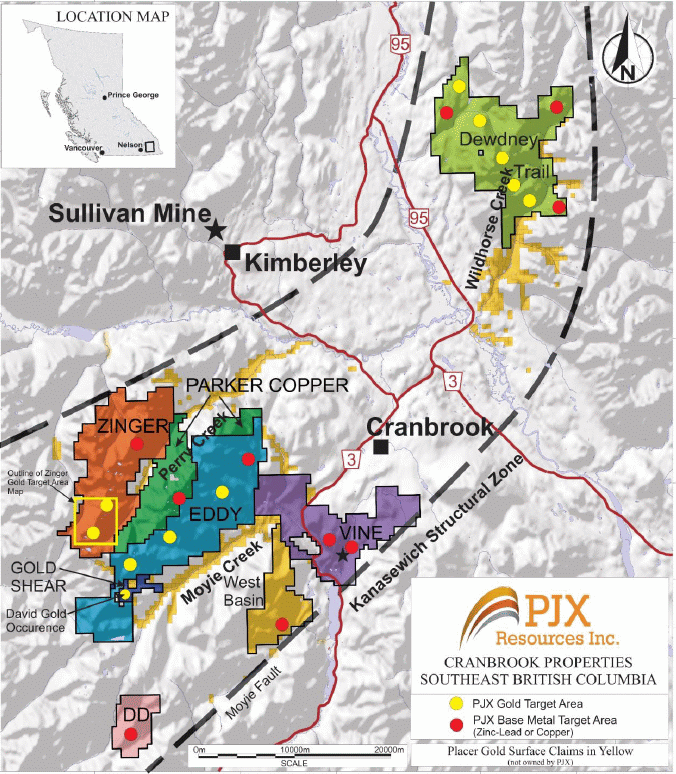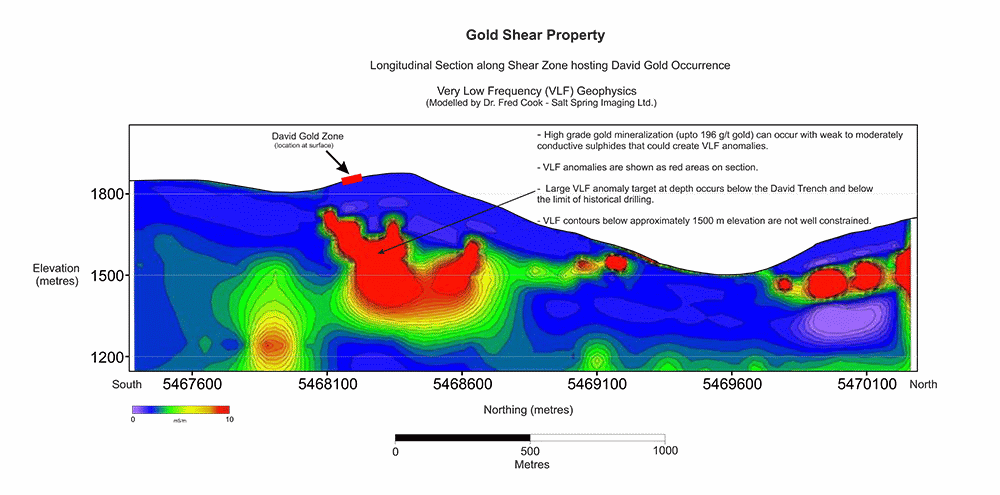| |
Tracker - September 11, 2019: PJX awaiting downhole probe results from Vine and assays from the Gold Shear
 PJX Resources Inc announced on August 18, 2019 that it has completed the second deep hole this year testing an MT anomaly on its 100% owned Vine project in southeastern British Columbia. The first hole completed in Q1 of 2019 failed to intersect anything that explained the MT anomaly projected to sit at a 800 m depth and plunge for about 2,000 m (see Tracker April 4, 2019). PJX's CEO John Keating believes the magneto-telluric anomaly which partly overlaps with a gravity anomaly is an iron sulphide (pyrrhotite) body containing lead-zinc-silver mineralization which formed as a Sedex deposit similar to Sullivan but which has been subjected to compression by the action of the nearby regional Moyie Fault. This could have folded the deposit upon itself and remobilized the massive sulphides to create what in Australia is called a Broken Hill style deposit of which Cannington is a more recently discovered example. A key result is the tendency of these metamorphic pressures to remobilize the zinc sphalerite and lead galena sulphides to segregate into their own adjoining horizons with silver ending up with the galena. In addition these sulphides also get remobilized through the surrounding rock to create fracture controlled massive sulphide mineralization such as was the original near surface focus at the Vine project. A downhole probe EM survey suggested the hole had missed the target by 100 m. Without any fanfare PJX started a second hole which made it 1,877 m to the Moyie Fault but also failed to intersect anything explaining the MT anomaly. However, at a depth of 777.1 m, which is above the projected 800 m deep top of the MT anomaly, the hole intersected a 5.5 m interval that contained 4 thin bedded massive sulphide horizons ranging 0.4 m to 1.4 m thick containing pyrrhotite, galena, sphalerite and chalcopyrite. The 1.4 m interval graded 0.52% copper, 0.63% lead, 0.45% zinc, 7.6 g/t silver with anomalous nickel (195 ppm) and cobalt (263 ppm). Although the overall grade and thickness do not constitute ore, PJX considers this outcome to be very significant because it is the first time bedded massive sulphides have been encountered on the Vine property. Furthermore, the bedding dips westward which corresponds to the projected dip of the MT anomaly. A downhole probe EM survey is planned to determine where the elusive target has squirted off to this time. Although these two holes were expensive, they are achieving a vectoring function, and the third hole may prove a charm in tagging a prize that has great size. Results for the downhole probe are expected by the end of September. PJX is also awaiting thin section work on part of the hole though he would not say why the results may be important. The junior has not published any graphics to help us understand what is going on, but Keating assures me this will be done when they are ready to spot the third hole. PJX Resources Inc announced on August 18, 2019 that it has completed the second deep hole this year testing an MT anomaly on its 100% owned Vine project in southeastern British Columbia. The first hole completed in Q1 of 2019 failed to intersect anything that explained the MT anomaly projected to sit at a 800 m depth and plunge for about 2,000 m (see Tracker April 4, 2019). PJX's CEO John Keating believes the magneto-telluric anomaly which partly overlaps with a gravity anomaly is an iron sulphide (pyrrhotite) body containing lead-zinc-silver mineralization which formed as a Sedex deposit similar to Sullivan but which has been subjected to compression by the action of the nearby regional Moyie Fault. This could have folded the deposit upon itself and remobilized the massive sulphides to create what in Australia is called a Broken Hill style deposit of which Cannington is a more recently discovered example. A key result is the tendency of these metamorphic pressures to remobilize the zinc sphalerite and lead galena sulphides to segregate into their own adjoining horizons with silver ending up with the galena. In addition these sulphides also get remobilized through the surrounding rock to create fracture controlled massive sulphide mineralization such as was the original near surface focus at the Vine project. A downhole probe EM survey suggested the hole had missed the target by 100 m. Without any fanfare PJX started a second hole which made it 1,877 m to the Moyie Fault but also failed to intersect anything explaining the MT anomaly. However, at a depth of 777.1 m, which is above the projected 800 m deep top of the MT anomaly, the hole intersected a 5.5 m interval that contained 4 thin bedded massive sulphide horizons ranging 0.4 m to 1.4 m thick containing pyrrhotite, galena, sphalerite and chalcopyrite. The 1.4 m interval graded 0.52% copper, 0.63% lead, 0.45% zinc, 7.6 g/t silver with anomalous nickel (195 ppm) and cobalt (263 ppm). Although the overall grade and thickness do not constitute ore, PJX considers this outcome to be very significant because it is the first time bedded massive sulphides have been encountered on the Vine property. Furthermore, the bedding dips westward which corresponds to the projected dip of the MT anomaly. A downhole probe EM survey is planned to determine where the elusive target has squirted off to this time. Although these two holes were expensive, they are achieving a vectoring function, and the third hole may prove a charm in tagging a prize that has great size. Results for the downhole probe are expected by the end of September. PJX is also awaiting thin section work on part of the hole though he would not say why the results may be important. The junior has not published any graphics to help us understand what is going on, but Keating assures me this will be done when they are ready to spot the third hole.

Meanwhile, PJX has completed 6 short holes into the David gold zone of the Gold Shear project which sits inside the Eddy property near its southwestern end. PJX introduced the Gold Shear drilling plan on July 24, 2019. The Gold Shear property was explored in 1990-96 by Dragoon and Greenstone which discovered the David deposit for which a pre-43-101 resource estimate of 96,000 tonnes of 13.08 g/t gold (uncut) was produced by Bapty Research Ltd in 1991. The property reverted to the vendors where it remained in limbo due to a conflict among them that did not get resolved until early 2018 when Keating managed to do a deal.

The Gold Shear property sits within the 30 km long Eddy property which covers the north flank of Moyie Creek which along with tributaries draining the Eddy property has been the focus of placer mining since the 1860's and continues to be so today. The geology consists of Purcell Basin sediments (quartzites and siltstones of the Middle Aldrige Formation) which developed a Riedel shear structure whose cross cutting quartz veins became the depositional centers for younger intrusion related fluid flow. Efforts during the late 19th century to find the bedrock source for the placer gold evaporated at the turn of the century when the monster Sullivan deposit was discovered and turned the entire region into a Hunt for Sullivan 2. The fact that the gold can be very high grade, as in the core sample above from the David zone where 0.8 m ran 196.69 g/t gold, and yet not be visible because of a close association with sulphide, attracted juniors during the seventies and eighties who could boast "outcrop gold" to attract funding for small drill programs that fueled stock promotions but rarely delivered results in the form of significant gold zones. That strategy no longer works today and PJX has over the years assembled a large land package in this area southeast of Cranbrook.

The Leapfrog 3D Model based on 70 historical shallow drill holes is a north-south section looking west which depicts a cigar like body plunging to the north. The limited tonnage of this zone, which was drilled off to a maximum depth of 150 m, and the implication that multiple such zones would have to be found along the trend of the shear structure to justify development, discouraged exploration during the past couple decades. Keating, however, is looking at the gold potential from a regional perspective. He thinks the setting has the potential to host thermal aureole style deposits such Uzbekistan's monster Muruntau deposit which has yielded over 170 million oz at 2 million oz per year and will do so for at least another decade. Obviously there is nothing like that sticking out of the ground in southeastern BC or it would have been found a long time ago, just as was the Sullivan deposit whose edge outcropped. But maybe the short and narrow high grade quartz veins that have shed the placer gold are peripheral to something much bigger at a depth never seriously tested in this region except when stalking Sullivan 2 targets such as PJX and Highway 50 are doing at their respective Vine and Monroe projects to the southeast.

What intrigues Keating is the VLF survey done on the Gold Shear property which depicts a substantial VLF anomaly beneath the known limits of the David Zone which, although the gold is associated with sulphides, does not even show up in this north-south section looking west which is about twice the scale of the 3D model graphic. This may be because the sulphides in the David zone are only weakly conductive. Conductive sulphides can be responsible for VLF, and if that is the explanation for the anomaly, does it carry any gold like the sulphides in the quartz veins of the David zone? PJX has conducted a modest 6 hole drill program with oriented core of which 5 holes have tested the existing zone because there is no core available from the past drilling and Keating wants original data from which he can also sort out the structural context. One hole was drilled deeper than the plunge but he would not say what it encountered. Assays are expected by early October. If the historic resource is reliable these results should be good and even contain the sort of high grade gold numbers that are all the rage these days. But their real value will be to create an interpretative framework for similar targets throughout the Eddy property, and for what it might suggest about the cause of the deeper conductive body. In early August before the second Vine hole results came out the stock got pounded down to $0.105 which I suspected might be by somebody who got word that the second hole had not explained the MT anomaly. But John Keating says this was a flow-through fund which unceremoniously decided to liquidate its position. The stock has since recovered and the market is waiting to find out if a third deep hole is justified at Vine, and what case can be made from the results of the redrilled David zone for drilling the deeper VLF target. PJX Resources Inc remains a Bottom-Fish Spec Value Favorite.
|